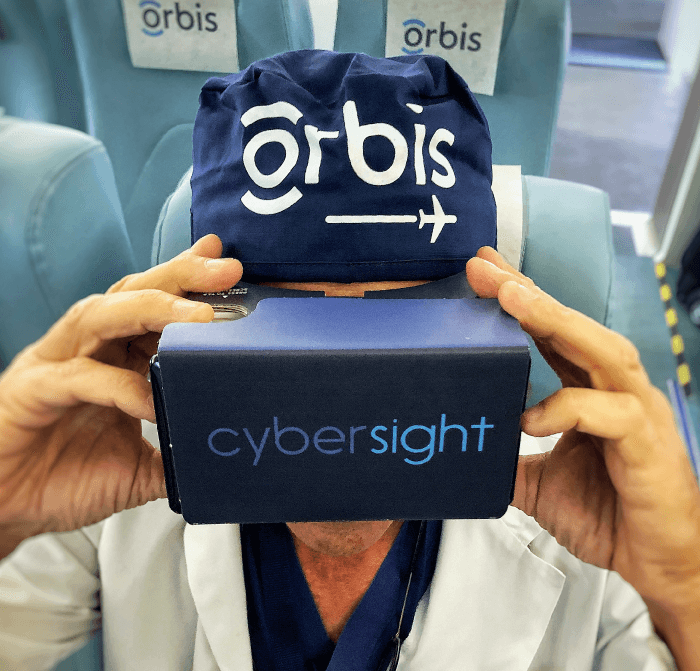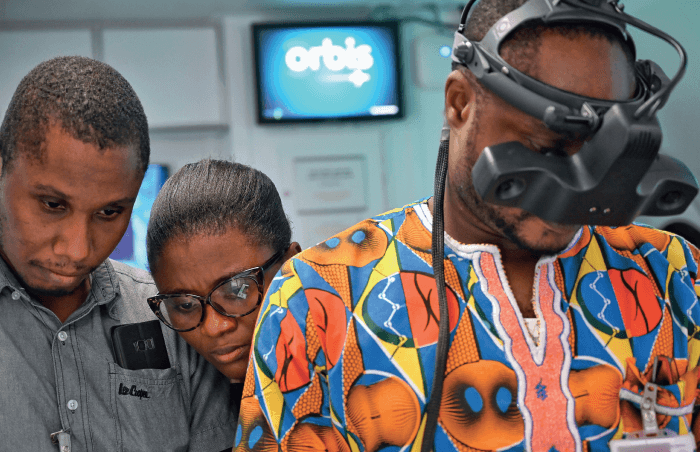
Daniel E. Neely, pediatric ophthalmologist at the Midwest Eye Institute and Professor of Ophthalmology at Indiana University School of Medicine, Indianapolis, Indiana, USA, explains how Cybersight is working to deliver care in compromised circumstances.
What has the COVID-19 pandemic been like for you and your patients?
In the US, during the worst outbreak of COVID-19, we were only seeing emergency patients – at most 10 percent of our usual schedules – and we suspended all surgical procedures. It later picked up to around 50 percent of our usual workload. During those strict lockdown weeks, we tried to conduct as many virtual appointments as we could. At Orbis, we are used to regularly employing innovative ways of communication, but this has been quite a new experience for us.
In your experience, how widespread was telemedicine in eye care before the pandemic?
Some settings offered this option, but it wasn’t common – more of a fringe service. During the pandemic, physicians in many places around the world were forced to conduct direct telemedicine consults. Just as children and university students got used to remote learning, doctors and patients have grown accustomed to remote care. In terms of telemedicine use, I can’t see us ever going back to where we were at the beginning of 2020. Telehealth and remote education now have a completely different acceptance level.
When I first started doing virtual appointments, we tried to replicate an office visit, going through the same processes and getting the same information we would in person – but we quickly found that this approach was not practical. The value of a virtual visit is the conversation you have with the patient, answering their questions, reassuring them. Most of the time, you can arrive at a diagnosis without a physical examination.
Orbis has used telemedicine for a long time; what did that look like?
We have been successfully applying telemedicine solutions since 1998, but not between the patient and the physician. Rather, they were between two physicians, one (based in an industrialized country) acting as a mentor, the other (in a developing country) as a mentee. Sustainability of eye care is crucial to Orbis. When we use our Flying Eye Hospital, we don’t just go to a location and perform a lot of surgical procedures. The goal is to pick cases that we can work on with local doctors and that they can perform on other patients once we are gone. Cybersight, the telemedicine platform we use, is just an extension of that. Its creator, Eugene Helveston, one of Orbis’ first volunteer faculty members, described it as “extended presence.” It allows us to meet at the same time, no matter where we are in the world.
What has changed for Cybersight since March this year?
Since the pandemic began, we have experienced record growth. Before March, we had between 600 and 700 new users a month. In March, when lockdowns started affecting various countries, this number doubled – and in April, the number of new registered users was around 3,400. Overall, Cybersight has had over 28,000 users from all over the world.
Our webinars before March attracted anywhere from 50 to 200 participants. Fast forward to May and, for each of the last three webinars we did, we had well over 1,000 participants. My last webinar attracted around 1,200 participants from 105 countries. Our webinars are usually in the form of hour-long lectures. After that hour, I offered to take questions; two hours later, I was still answering hundreds of questions from people around the world. This tells me how much such a service is needed, and it shows us that this really is a big moment for telemedicine. It’s like a switch has suddenly been flipped.
How long have you been using the platform yourself and how has it changed in that time?
I trained under Gene Helveston. I was his fellow in postgraduate training in 1998, when he first developed Cybersight after his trip to Cuba, and I have been using it ever since.
To give you a frame of reference on the state of technology back then, I received my first email only a year earlier, in 1997. I really wasn’t convinced that this was the future – I wasn’t sure why I needed an email account. As it turned out, the initial Cybersight consults were simply text emails! Eventually, Helveston was able to raise money for basic programming to create a web-based platform, which became the first phase of Cybersight that was donated to Orbis. For the next decade, it stayed in the format of three or four text boxes with some notifications. Afterwards, we got more financial support to get the platform to its current state: a consult service that looks a bit like an electronic medical record. The big changes have been the features we have incorporated into the platform.
Which features do you see as the most useful and innovative?
There is now an artificial intelligence feature, which can assess fundus photographs for signs of diabetic retinopathy, detect optic nerve anomalies, or estimate the cup-to-disc ratio. For the last few months, Cybersight has been employing a full-time AI programmer. Right now, AI is still in its infancy and it’s more of a novelty than it is a game changer, but eventually it will be everywhere in eye care. We need to be ready for when it really takes off – that is why we keep developing these solutions now.
We’re also working on incorporating AI into our digital resource library – hopefully directing doctors submitting a consult to all our existing resources on a particular topic or to similar cases that have already been assesse. The Cybersight library also has all the surgical videos that we record on the Flying Eye Hospital, narrated by the surgeon, with subtitles in different languages, and featuring answered questions from viewers.
As I mentioned before, we have a catalog of webinars given by international experts streamed simultaneously in all ocular subspecialties. These webinars come with subtitles, and we have had attendees from every country in the world. If we identify any gaps in this webinar catalog, we recruit a new member of faculty to give a lecture on that topic.

What are the pros and cons of learning remotely?
Remote education is a double-edged sword. Faculty don’t have to travel, so they are more likely to participate. For us, this opens up a much larger potential pool of available lecturers. However, participants don’t get to experience the special connection they would if they spent time together in person. Often, if you travel to a different location and work with other doctors, you become friends for life. This connection is important, especially when people are receiving advice about performing surgical procedures or dealing with patients. Mentees have to be able to trust you and get a sense of who you are – not just a talking head on a laptop.
On the other hand, participant anonymity can be an advantage for remote learning settings. If I gave a lecture in person, very few people would raise their hands and ask questions. A remote environment gives them the courage to ask the questions they want. After my last webinar, I had 296 questions – that would never happen in a lecture theater!
What features would you like to see the platform acquire in the future?
As I mentioned earlier, AI will become ubiquitous, and so will live surgical teaching, which we’ve only done a handful of times. We need an efficient system to do that from anywhere in the world. We also face some language barriers; we have faculty that speak various languages, but whereas we have thousands of users in India, we may only have hundreds of users in China because the language barrier is too intense. That is why we need improved, simultaneous, automated language translation. I would also like to see a regional component to the system, where mentors give advice to mentees from the same country or region, using our infrastructure, with no language barriers. This would open our service to many physicians who do not currently benefit from it.
It is estimated that the global number of people affected by blindness will triple by 2050 (1). As ophthalmologists, we cannot triple all our efforts in the next 30 years, but we can easily ramp up and triple our digital activities – we could scale them up by a factor of 100! The doctors to whom we give consultations are responsible for their patients and we can give them the tools to make the right decisions.
The pandemic has inevitably had an impact on our programs around the world and we are working closely with our in-country partners and local leaders to carefully monitor the COVID-19 situation as it evolves. Of course, the health and safety of staff, volunteers, partners, and the people we train and treat remains our highest priority. Our programs are following the direction of the WHO and continuing to provide essential and emergency eye care wherever possible.
We’ve made the difficult decision to ground the Orbis Flying Eye Hospital for the remainder of 2020. Despite this setback, we’re finding ways to work effectively with the local eye health professionals we support, equipping them with the resources they need to save and restore vision in their communities. Our incredible partners and volunteers are committed to Orbis’ sight-saving mission, and that means providing care in urgent cases – even in the midst of a pandemic.
One way we can aid the safe, socially responsible diagnosis and treatment of eye conditions is through Cybersight. It is proving to be a powerful tool and a lifeline for our hospital partners in low- and middle-income countries.
Much will need to be done to address the backlogs – both of people requiring sight-saving treatments and of those in need of screening to identify their existing eye conditions. Healthcare workers around the world are working tirelessly to fight this pandemic. This includes our incredible expert medical staff and volunteers, many of whom are now working on the frontline within the NHS in the UK. We are proud of, and inspired by, the dedication our local partners, volunteers, and staff show to their work and their patients, and we are unwavering in our support of them.
References
- RRA Bourne et al., “Magnitude, temporal trends, and projections of the global prevalence of blindness and distance and near vision impairment: A systematic review and meta-analysis,” Lancet Glob Health, 5, e888 (2017). PMID: 28779882.
